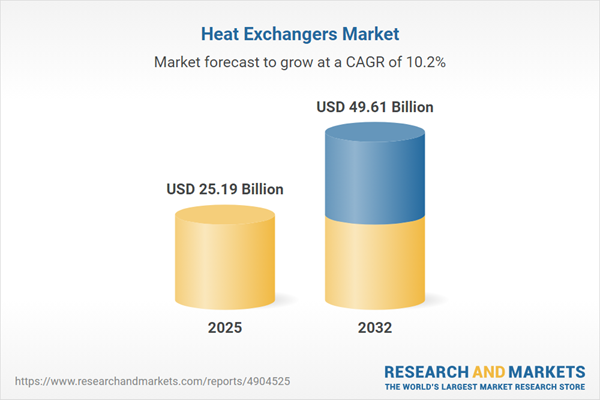Speak directly to the analyst to clarify any post sales queries you may have.
The heat exchangers market is advancing in response to global decarbonization efforts, technological integration, and evolving industry requirements. Senior leaders should understand how these trends are reshaping operational demands and competitive strategies across key markets.
Market Snapshot: Strong Growth and Innovation Drive Heat Exchanger Market
The heat exchangers market grew from USD 22.82 billion in 2024 to USD 25.19 billion in 2025 and is forecast to reach USD 49.61 billion by 2032, progressing at a CAGR of 10.19%. This robust trajectory is underpinned by increased industrial demand, investment in energy efficiency, and the uptake of advanced thermal management solutions. Organizations in chemicals, power generation, and heavy manufacturing prioritize these systems for cost management, regulatory compliance, and sustainability advancement as the sector evolves globally.
Scope & Segmentation: Comprehensive Heat Exchanger Landscape
- Type
- Air-Cooled: Compact Air-Cooled, Direct Air-Cooled, Indirect Air-Cooled
- Fluid-Cooled: Alkali-Cooled, Oil-Cooled, Water-Cooled
- Hybrid Heat Exchangers: Adiabatic Heat Exchangers, Evaporative Heat Exchangers
- Design
- Air Cooled Heat Exchangers: Horizontal Type, Vertical Type
- Plate Heat Exchangers: Brazed Plate, Gasketed Plate, Welded Plate
- Shell And Tube Heat Exchangers: Fixed Tube Sheet, Floating Head, U-Tube
- End-Use Industry
- Chemical Industry: Fertilizers, Petroleum Refining
- Energy & Power Industry: Non-Renewable Energy, Renewable Energy
- Manufacturing Industry: Automotive Manufacturing, Textiles Production
- Oil & Gas Industry
- Regions Covered
- Americas: North America (United States, Canada, Mexico), Latin America (Brazil, Argentina, Chile, Colombia, Peru)
- Europe, Middle East & Africa: Europe (United Kingdom, Germany, France, Russia, Italy, Spain, Netherlands, Sweden, Poland, Switzerland), Middle East (United Arab Emirates, Saudi Arabia, Qatar, Turkey, Israel), Africa (South Africa, Nigeria, Egypt, Kenya)
- Asia-Pacific: China, India, Japan, Australia, South Korea, Indonesia, Thailand, Malaysia, Singapore, Taiwan
- Leading Companies Profiled
- Aero Engineers Pvt. Ltd., Alfa Laval Corporate AB, API Heat Transfer Inc., Boyd Corporation, Chart Industries, Inc., Danfoss A/S, Enerquip, LLC, General Electric Company, Godrej Group, Güntner GmbH & Co. KG, Hindustan Dorr-Oliver Ltd., Hisaka Works, Ltd., HRS Heat Exchangers Ltd., IHI Corporation, Johnson Controls International PLC, Kaltra GmbH, Kelvion Holding GmbH, KGC Engineering Projects Private Ltd., Koch, Inc., Mason Manufacturing LLC, Modine Manufacturing Company, Nuberg Engineering Limited, Royal Hydraulics, Inc., Sierra S.p.A, Teksons Pvt. Ltd., Xylem Inc.
Key Takeaways: Strategic Insights for Senior Decision-Makers
- Energy efficiency mandates and net-zero commitments are driving innovation in heat exchanger materials, including advanced alloys that enhance performance and durability.
- Digitalization is transforming operational management, with adoption of predictive analytics and IoT-enabled monitoring systems now common across major industrial users.
- Supply chain realignment is accelerating, particularly in response to cost volatility and the need for agile sourcing of critical thermal components.
- Industry players are prioritizing modular and customizable designs, enabling faster scalability and integration with both legacy and new infrastructure.
- Sector-specific requirements—such as corrosion resistance in chemicals, or footprint minimization in manufacturing—shape product and procurement strategies across regions.
- Collaboration between OEMs, technology providers, and service specialists is expanding total solution offerings beyond equipment, focusing on ongoing support and lifecycle value.
Tariff Impact: Navigating Global Supply Chain Turbulence
Recent tariff adjustments in the United States have reshaped sourcing and supply chain strategies in the heat exchangers market. Manufacturers are diversifying supplier networks and reinforcing regional partnerships to reduce exposure to cross-border duties, increase transparency, and enhance resilience. Turnkey solutions that integrate equipment, installation, and service are favored for improved cost predictability and long-term value in a volatile regulatory environment.
Methodology & Data Sources
This research utilizes a blend of primary interviews with key industry stakeholders and in-depth secondary data analysis, cross-verified using established analytical frameworks. Expert reviews ensure reliable insights tailored for strategic business planning in the thermal management sector.
Why This Report Matters
- Analyze emerging opportunities and risks in the heat exchangers market to strengthen competitive positioning.
- Identify the technologies and regions driving future growth, helping you prioritize investments and optimize resource allocation.
- Gain actionable intelligence for resilient supply chain management and sustainable operational performance.
Conclusion
Industry leaders who act on innovation, digital transformation, and strategic partnerships will be best positioned for growth in the evolving heat exchangers market. Staying agile and informed will be critical to capturing value and navigating sector changes.
Additional Product Information:
- Purchase of this report includes 1 year online access with quarterly updates.
- This report can be updated on request. Please contact our Customer Experience team using the Ask a Question widget on our website.
Table of Contents
3. Executive Summary
4. Market Overview
7. Cumulative Impact of Artificial Intelligence 2025
Companies Mentioned
The companies profiled in this Heat Exchangers market report include:- Aero Engineers Pvt. Ltd.
- Alfa Laval Corporate AB
- API Heat Transfer Inc.
- Boyd Corporation
- Chart Industries, Inc.
- Danfoss A/S
- Enerquip, LLC
- General Electric Company
- Godrej Group
- Güntner GmbH & Co. KG
- Hindustan Dorr-Oliver Ltd.
- Hisaka Works, Ltd.
- HRS Heat Exchangers Ltd.
- IHI Corporation
- Johnson Controls International PLC
- Kaltra GmbH
- Kelvion Holding GmbH
- KGC Engineering Projects Private Ltd.
- Koch, Inc.
- Mason Manufacturing LLC
- Modine Manufacturing Company
- Nuberg Engineering Limited
- Royal Hydraulics, Inc.
- Sierra S.p.A
- Teksons Pvt. Ltd.
- Xylem Inc.
Table Information
| Report Attribute | Details |
|---|---|
| No. of Pages | 199 |
| Published | November 2025 |
| Forecast Period | 2025 - 2032 |
| Estimated Market Value ( USD | $ 25.19 Billion |
| Forecasted Market Value ( USD | $ 49.61 Billion |
| Compound Annual Growth Rate | 10.1% |
| Regions Covered | Global |
| No. of Companies Mentioned | 27 |









